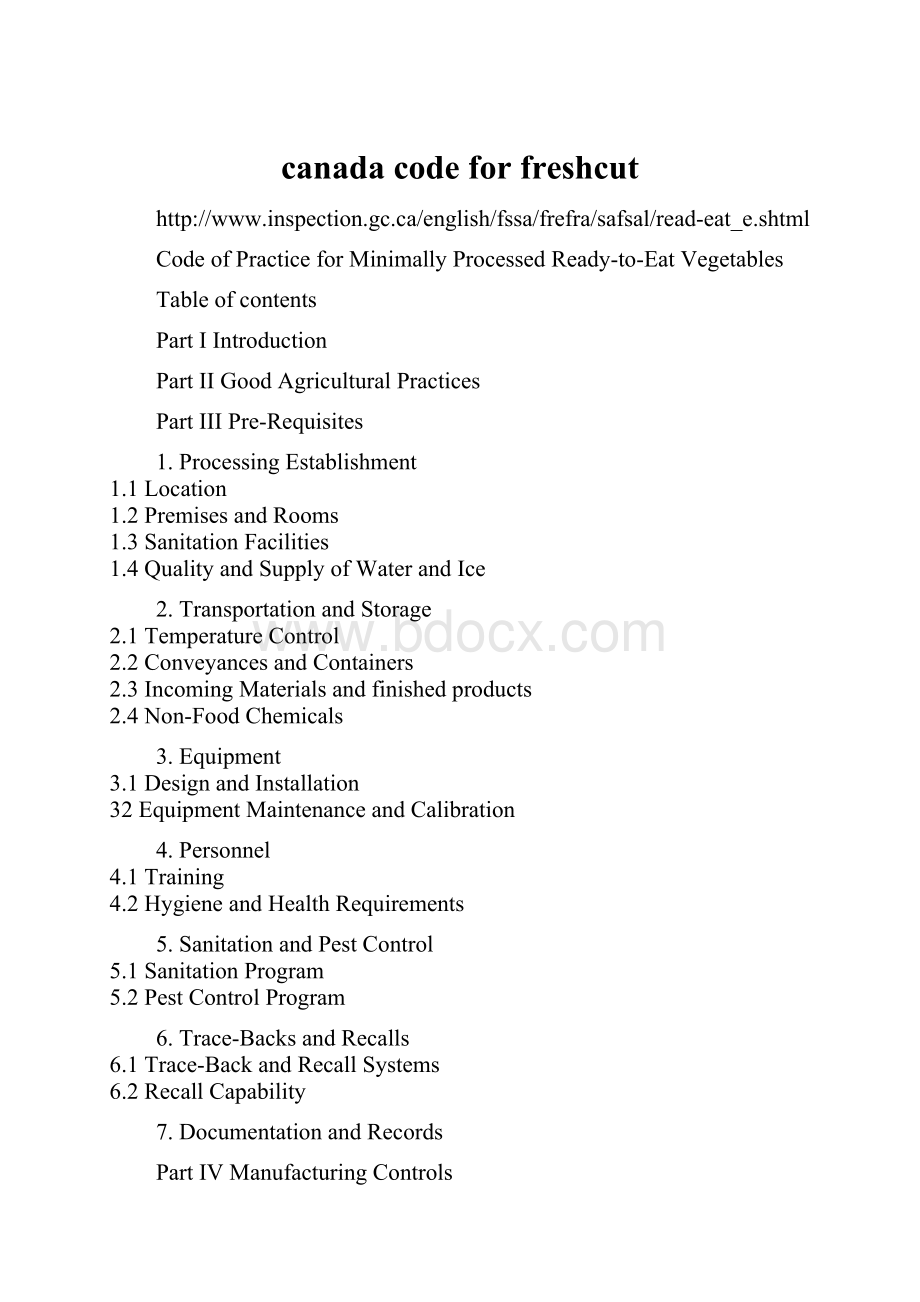canada code for freshcut.docx
《canada code for freshcut.docx》由会员分享,可在线阅读,更多相关《canada code for freshcut.docx(37页珍藏版)》请在冰豆网上搜索。

canadacodeforfreshcut
http:
//www.inspection.gc.ca/english/fssa/frefra/safsal/read-eat_e.shtml
CodeofPracticeforMinimallyProcessedReady-to-EatVegetables
Tableofcontents
PartIIntroduction
PartIIGoodAgriculturalPractices
PartIIIPre-Requisites
1.ProcessingEstablishment
1.1Location
1.2PremisesandRooms
1.3SanitationFacilities
1.4QualityandSupplyofWaterandIce
2.TransportationandStorage
2.1TemperatureControl
2.2ConveyancesandContainers
2.3IncomingMaterialsandfinishedproducts
2.4Non-FoodChemicals
3.Equipment
3.1DesignandInstallation
32EquipmentMaintenanceandCalibration
4.Personnel
4.1Training
4.2HygieneandHealthRequirements
5.SanitationandPestControl
5.1SanitationProgram
5.2PestControlProgram
6.Trace-BacksandRecalls
6.1Trace-BackandRecallSystems
6.2RecallCapability
7.DocumentationandRecords
PartIVManufacturingControls
1.ProcessDesign
1.1ShelfLifeValidation
2.ProductFormulation
2.1Specifications
2.2ProductFormula
3.IncomingMaterialControl
3.1IncomingMaterials
3.2IncomingMaterialControlRecords
4.PreprocessingandProcessing
4.1Inspection,Sorting,TrimmingandFirstWash
4.2Cutting,Slicing,ShreddingandGrinding
4.3Washing
4.4AntimicrobialTreatment
4.5AdherencetoProductFormulation
4.6ProductTemperatureduringProcessing
4.7ProductProcessingRecords
5.Packaging
5.1PackagingandContainers
5.2CriticalPackagingFactors
5.3PackagingRecords
6.ContainerCodingandLabelling
6.1ProductIdentification
6.2LabelAccuracy
6.3Coding-"Use-By"Date
6.4Labelling-StorageTemperature
7.DeviationsandCorrectiveAction
7.1DeviationControl
7.2CorrectiveAction
7.3DeviationandCorrectiveActionRecords
8.VerificationofProductSafety
8.1VerificationProcedures
8.2VerificationRecords
9.ComplaintHandling
9.1ProductComplaints
9.2ComplaintRecords
Glossary
PARTI INTRODUCTION
Background
Thehealthbenefitsassociatedwithfreshproducecombinedwiththeon-goingconsumertrendtowardeatingoutandconsumingready-to-eatfoodshavecontributedtoasubstantialincreaseinthepopularityofminimallyprocessedready-to-eatvegetables. Lettuceandothersaladvegetableswhichareminimallyprocessed(washed,trimmedandbagged)byfoodmanufacturersprovideconvenientproductstotheconsumer.
Theminimallyprocessedready-to-eatvegetableindustrywasinitiallydevelopedtosupplyrestaurants,hotelsandotherinstitutionsand,morerecently,wasexpandedtoincludefoodretailersforhomeconsumption.Althoughnodetailedstatisticalinformationisavailableonthevolumeofdomesticproductionorimportation,theseproductsappeartobegaininganincreasedmarketshare.
Whereasmostsaladsandothervegetablesarestillpreparedathome,theinclusionofminimallyprocessedready-to-eatvegetableshasmovedthepreparationoftheseproductsfromtheconsumer.Theincreasedtimeanddistancebetweenprocessingandconsumptionmaycontributetohigherrisksoffood-borneillness.Althoughchemicalandphysicalhazardsareofconcern;suchasthepresenceofagriculturalchemicalsandfoodadditivesabovethemaximumresiduelimitsorthepresenceofmetalsandotherinjuriousparticles;thehazardsspecifictominimallyprocessedready-to-eatvegetablesresidemainlywithmicrobialcontaminants.
SomeofthemicrobialpathogensassociatedwithfreshvegetablesincludeListeriamonocytogenes,Salmonellaspp.,Shigellaspp.,enteropathogenicstrainsofEscherichiacoli,hepatitisAvirus,etc.Thepossiblesourcesofcontaminationintheseproductsinvolvetheincomingrawvegetables,theplantworkers,andtheprocessingenvironment.Whenvegetablesarechoppedorshredded,thereleaseofplantcellularfluidsprovidesanutritivemediuminwhichmicroorganismscangrow.Thehighmoisturecontentoffreshvegetables,thelackoflethalprocesstoeliminatemicrobialpathogens,andthepotentialfortemperatureabuseduringpreparation,distributionandhandlingfurtherintensifytheriskoffood-borneillness.
Inresponsetotheincreasedconsumptionofminimallyprocessedready-to-eatvegetablesandtherisksoffood-borneillnessassociatedwiththeseproducts,governmentsandindustryhaveinitiatedworkinthedevelopmentofacodeofpracticeforthemanufacturingofminimallyprocessedready-to-eatvegetables.
Scope
Thiscodeofpracticehasbeendevelopedforthemanufacturingofminimallyprocessedready-to-eatvegetablesconsistingofrawvegetablesthathavebeenpeeled,sliced,choppedorshreddedpriortobeingpackagedforsaleinCanada.Applicableproductsincludeshreddedlettuce,shreddedcabbage,mixedvegetablesalads,groundbroccoliandpeeledbabycarrots.Packagingincludessingleservingcontainers(e.g.,sealedpouchesorplastictrays),largerconsumerorinstitutionalsizepackagesandbulkcontainers.Withthepossibleexceptionoftheadditionofdressingorcroutonsbytheend-user,theproductsdonotrequirefurtherpreparationbeforeconsumption.
Productsforwhichthiscodedoesnotapplyincludefreshvegetablesthathavebeentrimmedonlyandslicedpotatoesorothervegetablesthataredestinedforcooking(e.g.,frenchfries).Manufacturersofproductsthatarepreparedandconsumedonthepremisesthesameday(e.g.,restaurantsanddelicatessens)areexemptedfromthisstandard.
Althoughthereisnospecificregulationforminimallyprocessedready-to-eatvegetablesundertheCanadianAgriculturalProductsAct,theseproductsmustconformwithsections4and7oftheFoodandDrugsAct.Section4statesthat:
Nopersonshallsellanarticleoffoodthathasinoronitanypoisonousorharmfulsubstance;isunfitforhumanconsumption;consistsinwholeorinpartofanyfilthy,putrid,disgusting,rotten,decomposedordiseasedanimalorvegetablesubstance;isadulterated;orwasmanufactured,prepared,preserved,packagedorstoredunderunsanitaryconditions.Section7statesthat:
Nopersonshallmanufacture,prepare,preserve,packageorstoreforsaleanyfoodunderunsanitaryconditions.
UseoftheCode
Thiscodeisintendedtoprovideguidanceforthesafemanufacturingofminimallyprocessedready-to-eatvegetables.Asthereareseveralprocessesavailabletomanufacturetheseproducts,ageneralapproachhasbeentakenindevelopingthiscode.Itisnotintendedtocoverallpossiblemeansofimplementingpreventativemeasures.Alternativeapproachesmayapplyiftheyadequatelyminimizefoodsafetyhazards.Manufacturersareencouragedtousethegeneralrecommendationsofthiscodetotailorfoodsafetypracticesappropriatetotheirparticularoperations.
PartIIofthiscodeoutlinesGoodAgriculturalPracticesfortheprimaryproductionandharvestingoffreshvegetables.Althoughmanufacturersmaynotbeinvolvedintheprimaryproductionofvegetables,thissectionwasincludedinthecodetoraisetheawarenessofitsroleinthesafemanufacturingofminimallyprocessedready-to-eatvegetables.Acodeofpracticefortheprimaryproductionandharvestingoffreshproduceiscurrentlyindevelopment.Thiscodewillprovidefarmerswithguidanceforthehygienicproductionoffreshproduce.
PartIIIandIVofthiscodearecomposedofgeneralsafetyobjectivesfollowedbyspecificrecommendationsonhowtoachievethem.Itisimportanttoassessrecommendationsindividuallyand,whennecessary,consideralternativeapproachesthatmaybemoreappropriatetoparticularoperationsintheachievementofgeneralsafetyobjectives.
PARTIIGOODAGRICULTURALPRACTICES
Microbialandchemicalcontaminationmayoccurduringtheprimaryproductionandharvestingoffreshproduce.Thesafetyofminimallyprocessedready-to-eatvegetablesishighlyinfluencedbythedegreeofpreventativemeasuresusedonfarmtopreventcontamination.Growersshouldbeawareofgoodagriculturalpracticeswhichminimizerisksofmicrobial,chemicalandphysicalcontaminationduringtheprimaryproductionandharvestingoffreshproduce.Manufacturersshouldprescribegrowerstoadoptgoodagriculturalpracticesandprovideevidencethattheproductwasgrownaccordingtospecifications.
Thegeneralaspectsofthegoodagriculturalpracticestopromotesafetyoffreshproduceinclude:
LandUsage
Previousandpresentusageofthegrowingfieldandadjoiningsitesshouldbeevaluated(cropgrown,feedlot,toxicwastesite,etc.)toidentifypotentialsourcesofproducecontaminationsuchasagriculturalchemicals,fecalcontaminationorothertoxiccompounds.Stepsshouldbetakentopreventtheaccessoffarmandwildanimalstothesitestoavoidpotentialfecalcontaminationofthesoilandtheriskofcontaminatingcrop.
NaturalFertilizer
Theuseofnaturalfertilizers(e.g.,manure,organicmaterials,slaughterwastes,sewagesludge,etc.)intheproductionofproduceshouldbemanagedtolimitthepotentialformicrobialandchemicalcontaminationofproduce.Naturalfertilizersshouldbeproperlytreated(composting,pasteurization,heatdrying,(UVirradiation,alkalidigestionorcombinationsofthese)tominimizethepotentialformicrobialpathogens.
AgriculturalWater
Waterusedforirrigationandfumigationisapotentialsourceofcontaminationasitmaycontainmicrobialpathogens,heavymetalsandotherchemicals.Growersshouldevaluatethesourceofwaterusedonthefarm(well,opencanal,reservoir,re-usedirrigationwater,municipality,rivers,lakes,etc.),monitoritssafetyandcontrolpotentialsourcesofcontamination.
AgriculturalChemicals
Growersshouldonlyuseagriculturalchemicalswhichareacceptableforthecultivationofthespecificproduceandshouldusethemaccordingtomanufacturer’sinstructionsfortheintendedpur